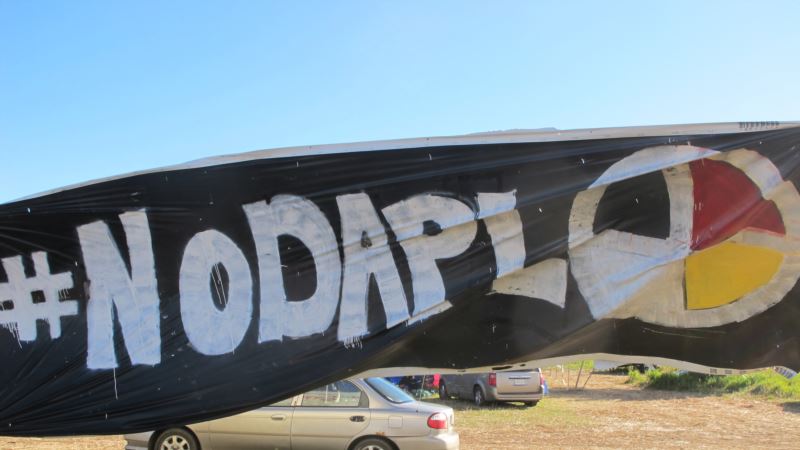The Dakota Access pipeline is a 1700 kilometer (1100 Mile) pipeline that is intended to transport the 400,000 barrels of oil that are coming from the Bakken and Three Forks oil fields in the U.S. State of North Dakota every day. Currently most of that oil is transported by train. The oil is a product of hydraulic fracturing (fracking) in the region and the pipeline would make it's way across four U.S. states, North Dakota, South Dakota, Iowa, then end up in Patoka, Illinois. From there, other pipelines can re-route it all over the country to shipping ports and refineries. The company building the pipeline is Dakota Access LLC, and they are an offshoot of a larger company called Energy Transfer that controls about 114,000 kilometers (71000 m) of pipeline that crisscrosses the United States. The company has been building the pipeline since 2015 and according to Catherine Collentine from the Sierra Club it's more than half complete. Why the protests? No doubt you've also heard or read something about the protests that are taking place around the building of the pipeline. This weekend dozens of people were arrested when they trespassed on private property that is in the pipelines right of way. Local police also confirmed that a drone flying above the scene of the protests was shot at by law enforcement officials. What is going on here? Well These protests, the pipeline and the pipeline building process involved is worth taking some time to understand. Because we here at VOA think it says a lot about the good and bad of American infrastructure, and democracy. Native Americans have been protesting the building of the pipeline for nearly two years. But they ratcheted up in intensity in July when the U.S. Army Corps of Engineers granted the builders a permit allowing the pipeline to cross under the Missouri River at a place called Lake Oahe, which is just about half a mile North of the the Standing Rock Sioux Indian Reservation. The Indians are protesting for a number of reasons. The first is that they get their water from the Missouri River and any oil spill puts their supply at risk. Second, the construction will dig up, and in fact may already have dug up areas the Sioux claim are sacred archaeological and burial sites. And finally, the Standing Rock Sioux say they weren't consulted by the Army Corps when they were investigating the pipeline. The first and obvious question is: what is the Army Corps of Engineers (ACoE) and why are they even involved? The Army Corps was established over two hundred years ago. In those early years, the Corps was put in charge surveying roads and canals “of national importance, in commercial or military point of view, or necessary for the transportation of public mail.” That broad mandate continues to this day and has expanded as the United States has grown. When the Clean Water Act was passed, the ACoE became the lead organization in charge of making sure that any construction or other projects are in compliance with that act, and don't for instance, put the nation's water supply at risk. They're required to study the potential environmental impact of any project before giving it the go ahead. And so today, the Army Corps according to their website, "evaluates permit applications for essentially all construction activities that occur in the Nation's waters, including wetlands." The Army Corps and Native Americans But things get even more complicated when any construction involves Native Americans. The early history of the United States in regards to treatment of its indigenous peoples is not one that Americans can view with much pride. During the rapid westward expansion of the United States, whole tribes of Indians were forced off of land they had occupied for centuries and relocated to reservations. In an attempt to make up for that forced relocation, laws have been passed over the past hundred years or so that take into account the fact that where Native Americans live now, may have no relationship to where they lived historically. That means land that American Indians don't occupy may be the places where they raised their families and buried their dead, and so have great religious and archaeological significance. To take this into account, when the Army is considering any construction project, they "must make a reasonable and good faith effort to identify Indian tribes that attach such significance but may now live at great distances from the undertaking's area of potential effect." In other words, Native Americans have to be consulted before things get dug up on land where they once lived. And that's the problem! The Standing Rock Sioux say that in this case the Army Corps didn't consult them. The Army Corps says they did, and that back and forth is still being decided by U.S. legal authorities. The most recent court decision came down in favor of the Pipeline in September when a district judge ruled that the Army Corps "likely complied" with the law and allowed construction to move forward. Then, within hours of that ruling, the Justice Department, the Department of the Army and the Interior Department sent out an injuction stopping any construction on that land the Sioux say is sacred. In a joint statement the three departments said the decision to stop construction would allow them to "determine whether it will need to reconsider any of its previous decisions regarding the Lake Oahe site under the National Environmental Policy Act (NEPA) or other federal laws." VOA Spoke to Phil McKenna who has been reporting on this story for Inside Climate News and he believes "that announcement from the Obama administration galvanized the opposition." VOA also spoke with Catherine Collentine from the Sierra Club who says the Obama Administration must step in. "This is one of those examples," she says, "where the administration should see that this should not have happened and this never should have started." The protestors are demanding that the Army Corps of Engineers conduct what McKenna calls "an Environmental Impact Statement." He adds, "They are also challenging the fact tracking process" the Army Corps used to approve the pipeline." So what did they say about this pipeline? But as the legal case moves forward hundreds of people have come to Lake Oahe to join the Standing Rock Sioux in their protest against the pipeline. More than half of all the Native American tribes in the U.S. have pledged solidarity with the Sioux, and a number of members of Congress have written letters urging the Obama administration to step in and stop the pipeline. The protests have at times been tense, construction equipment has been vandalized and security dogs have allegedly attacked and hurt protestors, including children. Also, at least two journalists have been arrested on charges of rioting, though some of those charges have been dropped. So what happens next? The Protestors and say they will remain on watch, and are preparing for the bitterly cold North Dakota winters. The construction team meanwhile continues to build the pipeline in other areas where there is no controversy though the company says the delays caused by the protests are costing them billions of dollars. The next big legal step for the case will come when the Army Corps of Engineers announces whether or not they will take a second, closer look at the possible environmental impacts of building a pipeline across the Missouri river. Mckenna says that "decision on the pipeline will be coming in weeks not months." From the viewpoint of the Sierra Club's Collenstein the Federal government has a clear mandate. "This project is large," she says, "and has extensive impact on sacred sites that are covered" under a number of different pieces of legislation. She says that requires them to pause construction and make sure the water stays clean, and that the rights of the first Americans are respected.
The Real Story: The Dakota Access Pipeline






